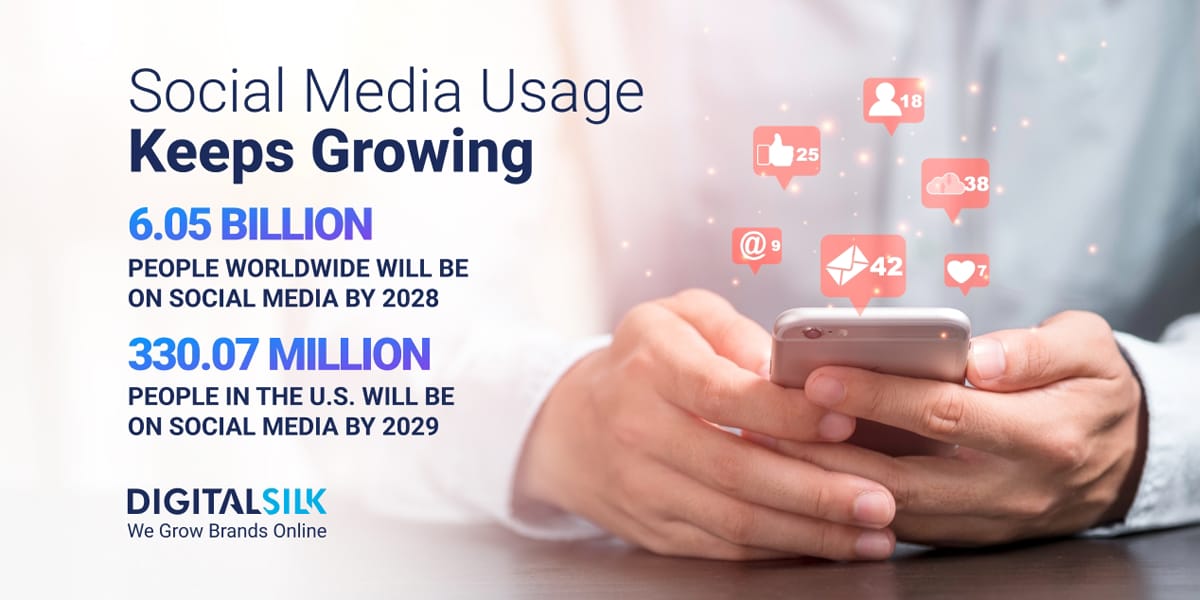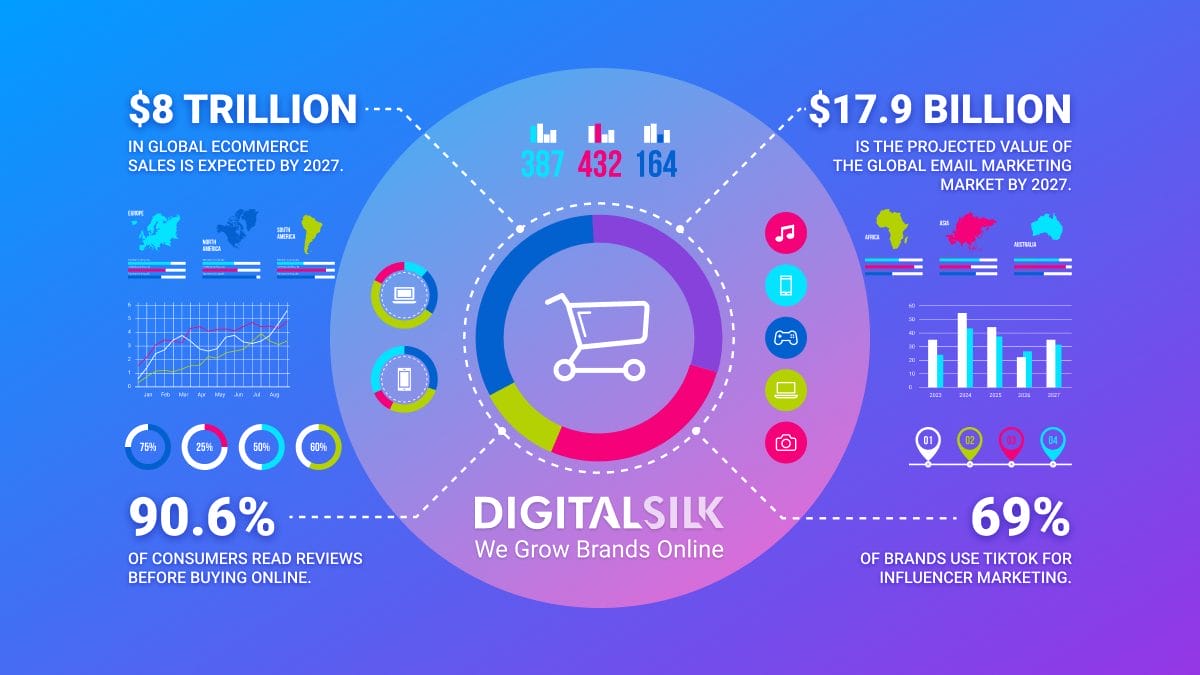The most recent social media statistics show how popular platforms impact our everyday lives, shaping the ways we communicate and influencing our purchasing decisions.
For many, social media has become the main source of social interaction, entertainment, news and discovering new products.
With social media deeply embedded in our daily lives, it’s important to examine the numbers that reflect its influence:
- How many people use social media?
- How many users do the world’s biggest platforms have?
- Why is social media one of the best places to promote your brand?
We’ll break down the latest statistics to answer these and many other important questions.
General Social Media Statistics
You may know that the majority of the world’s population is now on social media, but just how many people are connected through these platforms? And how much time do they spend scrolling through their feeds?
Let’s dive into some precise numbers to truly understand the scale of social media:
- 5.24 billion people in the world use social media.
- It’s estimated that the number of social media users worldwide will reach 6.05 billion by 2028.
- 330.07 million people in the U.S. will use social media by 2029.
- Northern Europe is the region with the highest social media penetration, at 78.7%.
- An average user spends 143 minutes per day on social media.
- In the U.S., people spend 14.02% of their waking hours on social media.
- 62% of people say they use social media to stay in touch with friends, family and colleagues.
- 25% of adults in the U.S. say they often get news from social media.
- In 2025, U.S. users will spend 61.1% of their time on social networks watching videos.
- 51.2% of social media users in the U.S. are female while 48.8% are male.
With over 5 billion people on social media and the average user spending over two hours a day on these platforms, your brand can’t afford to sit on the sidelines.
A targeted, data-driven and well-designed social media strategy is essential for staying competitive, connecting with your audience, increasing visibility and driving engagement.
Social Media Users By Age
When social media first emerged, it was primarily embraced by younger generations.
Fast forward to 2025, and people of all ages are active on platforms such as Facebook, Instagram and X.
However, the ways different age groups interact with social media vary:
- 37% of social media users in the U.S. are Millennials. 28% are Generation X and 25% are Gen Z.
- 46% of Gen Z use social media as the first search option for online search.
- 65% of Gen Z in the U.S. use Instagram, making it the most popular platform among the generation. It’s followed by YouTube at 63% and TikTok at 58%.
- 31.7% of Instagram users are aged 18-24. 30.6% are aged 25-34, while 16% are aged 35-44.
- 28% of Gen Z exchange Instagram handles after meeting someone new as opposed to exchanging phone numbers.
- In the U.S., there will be a combined 135.5 million Gen Z and Millennial users on social media by 2027.
- 50.6% of LinkedIn users are aged 25-34.
- 36.4 million Baby Boomers in the U.S. are on social media.
- Baby Boomers make up the largest chunk of weekly Facebook users, at 29%.
- 45% of parents in New York think their children spend too much time on social media.
The social media usage statistics above show that social media has truly become a cross-generational phenomenon, with Millennials, Gen Z, Gen X and even Baby Boomers actively engaging with content.
However, each generation has its own preferences when it comes to platforms and usage habits.
To maximize reach and engagement, brands must tailor their content formats, platform choices and messaging to cater to different demographics and the ways they engage with content.
TikTok has emerged as the go-to platform for Gen Z who prefer short and engaging video content while Facebook remains dominant among older generations, particularly Baby Boomers.
The Most Popular Social Media Platforms
The number of social media platforms continues to increase, but a select few dominate the internet, attracting billions of users worldwide.
From the long-standing giant Facebook to the global short-form video sensation TikTok, these platforms are where most online interactions take place:
- Facebook is the world’s most-used social media platform with 3.06 billion global users.
- 83% of all social media users have a Facebook profile.
- 45.5% of all social media visits in the U.S. go to Facebook.
- 22.4% of all time spent on social media in the U.S. goes to Facebook. Instagram and TikTok are tied for second place at 18.6% each.
- 165.8 million people in the U.S. use Instagram.
- YouTube has the highest brand awareness among social media platforms in the U.S., at 96%. It’s followed by Facebook at 95% and Instagram at 93%.
- TikTok user base is skyrocketing, with the expected number of users worldwide by 2029 projected to be 2.35 billion.
- 59% of adults in the U.S. use TikTok.
- Pinterest has 553 million monthly users.
- LinkedIn has over one billion members worldwide.
Social media platforms are no longer just communication tools — they’ve evolved into global hubs of engagement, discovery and commerce.
The dominance of Facebook remains unchallenged, while Instagram and TikTok are gaining ground with younger audiences, thanks to visually-driven, short-form content.
YouTube remains the top platform for brand awareness and video content consumption.
As TikTok’s meteoric rise continues, brands must rethink their platform strategies by investing in video-first content and engaging storytelling to capture the attention of younger generations.
Adapting to these trends ensures brands stay relevant and competitive.
The Most Popular Social Media Apps
Most users engage with social media through mobile devices.
With billions of people interacting, posting and sharing on these platforms, social media apps have come to dominate global download charts:
- TikTok is the world’s most popular app with 825.48 million downloads in 2024.
- Instagram ranks second in the world with 817.49 million downloads in 2024.
- Facebook has 597.87 million downloads in 2024.
- WhatsApp has been downloaded 564.33 times in 2024.
- An average person spends 35.1% of their mobile time using social media apps.
Since most social media users access their accounts via mobile devices, it’s critical for brands to optimize their content for mobile-first experiences.
Social Media Marketing Statistics
With billions of people on social media, businesses across all industries are using these platforms to connect with their audiences and promote their brands.
The data reveals just how effective social media marketing can be:
- 86% of marketers use Facebook, making it the most popular social media platform for marketing purposes. Instagram ranks second at 79% while LinkedIn is third at 65%.
- 70% of brands in the U.S. are on Facebook. 62% are on YouTube and 50% on Instagram.
- 61% of social media users turn to Instagram for product discovery.
- 83% of marketers say that their social media efforts generate increased exposure for their businesses.
- 54% of people under the age of 41 say social media ads influence their purchasing decisions the most.
- 56% of consumers say that brands should be more relatable on social media.
- 43% of social media users follow at least one brand or company.
- 35% of social media marketers say that short-form videos offer the highest ROI of all social content formats.
- The median engagement rate across all industries on TikTok is 2.63%.
- The global social media advertising market is projected to reach $256.5 billion in 2025.
Social media marketing is a key driver of brand visibility, with 83% of marketers seeing increased exposure and short-form videos delivering the highest ROI.
As the social media ad market continues to grow, brands should focus on relatable content, engaging video formats and authentic interactions to maximize impact.
Social Shopping Statistics
Social media is no longer just a place where you can connect with friends and family — it has evolved into a powerful marketplace where users can discover new products and make purchases.
Let’s look at the statistics that highlight the size and impact of social shopping is in 2025:
- As of 2025, the penetration rate of social shopping in the world is 31%.
- 24% of social shoppers say they’re most likely to make a purchase on Facebook. Instagram ranks second at 20% while TikTok is third at 13%.
- Millennials make up for 33% of all social commerce spending worldwide. Gen Z rank second at 29% and Gen X are third at 28%.
- By 2028, 21.7% of all eCommerce sales worldwide will take place through social media platforms.
- Social commerce revenue will reach $1.08 trillion by 2028.
Social shopping is booming, with 31% global penetration and $1.08 trillion in projected revenue by 2028.
As Millennials and Gen Z lead this shift, brands should establish a presence on platforms like Facebook, Instagram and TikTok to engage users where they shop.
The Use Of AI In Social Media
Over the past few years, artificial intelligence (AI) has found its use across various industries. Content creators and brands are now harnessing its power to enhance their social media presence. Recent statistics show just how essential AI has become in the world of social media:
- 61% of organizations say the number one reason why they use AI for social media is to reduce staff workload.
- 38% of marketers said increased efficiency is the main benefit of using AI in social media marketing.
- Businesses using AI for social media content generation report a 15-25% increase in engagement rates.
- 62% of global marketers believe having required labels for AI-generated content would have a positive effect on social media performance.
- The global AI in social media market is projected to reach $11.99 billion by 2031.
As the data suggests, businesses that integrate AI into their social media marketing strategies can expect increased efficiency and higher engagement rates.
There’s no doubt AI will continue to play a significant role in social media in the coming years, with new trends like AI influencers already gaining traction.
Grow Your Brand On Social Media With Digital Silk
The social media statistics we listed in this article indicate that social media is something businesses cannot ignore. With billions of users across the world, it has become the go-to place for connecting with target audiences and driving engagement.
With a well-designed social media strategy, your business can increase brand awareness, foster customer trust and drive meaningful interactions that lead to conversions.
At Digital Silk, we offer digital marketing services and our team of social media experts can help you build presence on your preferred platforms through data-driven optimization.
Other services we offer include:
- Social media marketing
- Custom web design
- Custom web development
- Branding
- Search engine optimization (SEO)
Contact us online, call us at (800) 206-9413 or fill in the Request a Quote form below to schedule a consultation.
"*" indicates required fields









